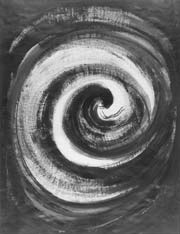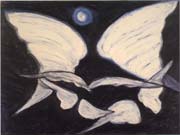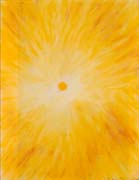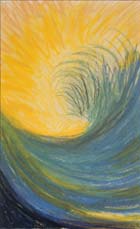Videos of Expressive Arts Therapy as Strategy to Resolve Personal Issues
When art and psychotherapy are joined, the scope and depth of each tin be expanded, and when working together, they are tied to the continuities of humanity's history of healing. —Shaun McNiff, The Arts and Psychotherapy
Function of the psychotherapeutic process is to awaken the creative life-force energy. Thus, inventiveness and therapy overlap. What is creative is frequently therapeutic. What is therapeutic is oft a artistic process. Having integrated the artistic arts into my therapeutic practice, I apply the term person-centered expressive arts therapy. The terms expressive therapy or expressive arts therapy by and large announce trip the light fantastic therapy, fine art therapy, and music therapy. These terms also include therapy through journal writing, poetry, imagery, meditation, and improvisational drama. Using the expressive arts to foster emotional healing, resolve inner conflict, and awaken individual creativity is an expanding field. In the capacity that follow, I hope to encourage you lot to add expressive arts to your personal and professional lives in ways that enhance your power to know yourself, to cultivate deeper relationships, and to enrich your methods as an creative person, therapist, and group facilitator.
What is expressive arts therapy?
Expressive arts therapy uses diverse arts—movement, drawing, painting, sculpting, music, writing, sound, and improvisation—in a supportive setting to facilitate growth and healing. It is a process of discovering ourselves through any fine art form that comes from an emotional depth. It is not creating a "pretty" moving picture. It is non a dance ready for the stage. It is not a poem written and rewritten to perfection.
We express inner feelings by creating outer forms. Expressive fine art refers to using the emotional, intuitive aspects of ourselves in various media. To use the arts expressively means going into our inner realms to detect feelings and to express them through visual fine art, movement, sound, writing, or drama. Talking about our feelings is likewise an important mode to limited and discover ourselves meaningfully. In the therapeutic world based on humanistic principles, the term expressive therapy has been reserved for nonverbal and/or metaphoric expression. Humanistic expressive arts therapy differs from the analytic or medical model of art therapy, in which art is used to diagnose, analyze and "care for" people.
Most of us have already discovered some attribute of expressive fine art as being helpful in our daily lives. You may doodle as yous speak on the telephone and find it soothing. Y'all may write a personal journal and find that equally y'all write, your feelings and ideas change. Perchance you write down your dreams and wait for patterns and symbols. You lot may paint or sculpt as a hobby and realize the intensity of the experience transports you out of your everyday problems. Or perhaps you sing while you drive or go for long walks. These exemplify cocky-expression through movement, sound, writing, and fine art to modify your state of being. They are ways to release your feelings, clear your mind, raise your spirits, and bring yourself into higher states of consciousness. The process is therapeutic.
When using the arts for self-healing or therapeutic purposes, we are not concerned about the beauty of the visual fine art, the grammar and mode of the writing, or the harmonic menstruum of the song. Nosotros use the arts to let go, to limited, and to release. Too, we tin can gain insight past studying the symbolic and metaphoric messages. Our art speaks dorsum to u.s.a. if nosotros take the time to let in those letters.
Although interesting and sometimes dramatic products sally, nosotros leave the aesthetics and the craftsmanship to those who wish to pursue the arts professionally. Of form, some of u.s. become so involved in the arts every bit cocky-expression that we later choose to pursue the skills of a particular fine art form. Many artist-therapists shift from focusing on their therapist lives to their lives equally artists. Many artists understand the healing aspects of the artistic process and get artist-therapists.
Using the creative process for deep inner healing entails further steps when nosotros work with clients. Expressive arts therapists are aware that involving the mind, the body, and the emotions brings forth the client'south intuitive, imaginative abilities equally well as logical, linear thought. Since emotional states are seldom logical, the use of imagery and nonverbal modes allows the client an alternate path for self-exploration and communication. This procedure is a powerful integrative force.
Traditionally, psychotherapy is a verbal form of therapy, and the verbal process will always be important. However, I notice I can quickly understand the world of the client when she expresses herself through images. Colour, form, and symbols are languages that speak from the unconscious and have particular meanings for each private. As I listen to a client'due south explanation of her imagery, I poignantly see the world every bit she views it. Or she may use movement and gesture to show how she feels. As I witness her motion, I can sympathise her globe by empathizing kinesthetically.
The client'due south self-knowledge expands as her movement, art, writing, and sound provide clues for further exploration. Using expressive arts becomes a healing process every bit well as a new language that speaks to both customer and therapist. These arts are strong media in which to discover, experience, and accept unknown aspects of self. Exact therapy focuses on emotional disturbances and inappropriate beliefs. The expressive arts move the customer into the world of emotions and add together a further dimension. Incorporating the arts into psychotherapy offers the client a manner to use the free-spirited parts of herself. Therapy may include joyful, lively learning on many levels: the sensory, kinesthetic, conceptual, emotional and mythic. Clients study that the expressive arts have helped them go across their problems to envisioning themselves taking activeness in the globe constructively.
What Is Person-Centered?
The person-centered aspect of expressive arts therapy describes the basic philosophy underlying my piece of work. The client-centered or person-centered approach developed past my father, Carl Rogers, emphasizes the therapist'southward function every bit beingness empathic, open, honest, congruent, and caring equally she listens in depth and facilitates the growth of an individual or a group. This philosophy incorporates the belief that each individual has worth, dignity, and the chapters for self-direction. Carl Rogers's philosophy is based on a trust in an inherent impulse toward growth in every individual. I base my approach to expressive arts therapy on this very deep faith in the innate capacity of each person to reach toward her full potential.
Carl'south research into the psychotherapeutic process revealed that when a client felt accepted and understood, healing occurred. It is a rare feel to feel accepted and understood when you are feeling fear, rage, grief, or jealousy. Yet it is this very acceptance and understanding that heals. Every bit friends and therapists, we frequently think we must accept an answer or give advice. However, this overlooks a very basic truth. Past genuinely hearing the depth of the emotional pain and respecting the individual'southward ability to observe her own answer, nosotros are giving her the greatest gift.
Empathy and acceptance give the individual an opportunity to empower herself and discover her unique potential. This atmosphere of understanding and credence likewise allows y'all, your friends, or your clients to feel prophylactic enough to attempt expressive arts as a path to becoming whole.
The Artistic Connexion
I am intrigued with what I call the creative connection: the enhancing coaction amid movement, art, writing, and sound. Moving with awareness, for case, opens us to profound feelings which can then be expressed in color, line, or course. When nosotros write immediately after the motility and art, a free flow emerges in the procedure, sometimes resulting in poetry. The Creative Connection process that I have adult stimulates such cocky-exploration. Information technology is like the unfolding petals of a lotus blossom on a summer 24-hour interval. In the warm, accepting environment, the petals open to reveal the bloom'due south inner essence. Every bit our feelings are tapped, they become a resource for farther self-understanding and creativity. We gently permit ourselves to awaken to new possibilities. With each opening we may deepen our feel. When we attain our inner cadre, we notice our connection to all beings. We create to connect to our inner source and to reach out to the world and the universe.
Some writers, artists and musicians are already aware of the creative connection. If yous are one of those, you lot may say, "Of grade, I always put on music and dance before I paint." Or, as a writer, you may go for a long walk before you sit at your desk. Yet, you are not lone if y'all are one of the many in our society who say, "I'm not creative." I hope this book entices you to try new experiences. You will surprise yourself.
I believe nosotros are all capable of beingness profoundly, beautifully artistic, whether nosotros employ that creativity to relate to family or to paint a flick. The seeds of much of our inventiveness come from the unconscious, our feelings, and our intuition. The unconscious is our deep well. Many of us have put a lid over that well. Feelings can be constructively channeled into artistic ventures: into dance, music, fine art, or writing. When our feelings are joyful, the art form uplifts. When our feelings are tearing or wrathful, we can transform them into powerful art rather than venting them on the world. Such art helps the states accept that attribute of ourselves. Self-acceptance is paramount to compassion for others.
The Healing Power of Person-Centered Expressive Arts
I discovered personal healing for myself equally I brought together my interests in psychotherapy, fine art, dance, writing, and music. Person-centered expressive therapy was born out of my personal integration of the arts and the philosophy I had inherited. Through experimentation I gained insight from my art journal. I doodled, let off steam, or played with colors without concern for the outcome. Unsure at first virtually introducing these methods to clients, I suggested they endeavour things and so asked them for feedback. They said it was helpful. Their self-understanding increased rapidly and the communication between us improved immensely.
The same was true equally I introduced movement, sound, and freewriting for self-expression. Clients and group participants reported a sense of "new beginnings" and freedom to be. 1 group member wrote: "I learned to play over again, how to let go of what I 'know'—my successes, achievements, and knowledge. I discovered the importance of being able to brainstorm again." Some other said: "Information technology is much easier for me to bargain with some heavy emotions through expressive play than through thinking and talking about it."
It became apparent that the Creative Connection process fosters integration. This is clearly stated by 1 customer who said, "I discovered in exploring my feelings that I could interruption through inner barriers/structures that I set for myself by moving and dancing the emotions. To depict that feeling after the motion continued the process of unfolding."
It is hard to convey in words the depth and power of the expressive arts process. I would like to share a personal episode in which using expressive arts helped me through a hard period. I promise that, in reading it, you will vicariously experience my procedure of growth through movement, art, and journal writing in an accepting surroundings.
The months after my male parent's death were an emotional roller coaster for me. The loss felt huge, yet in that location was also a sense that I had been released. My inner feeling was that his passing had opened a psychic door for me equally well as having brought great sorrow.
Expressive arts served me well during that fourth dimension of mourning. 2 artist-therapist friends invited me to spend fourth dimension working with them. Connie Smith Siegel invited me to spend a week at a cottage on Bolinas Bay. I painted one blackness picture subsequently another. Every time I became bored with such dark images, I would start another painting. Information technology, too, became moody and bleak. Although Connie is primarily an artist, her therapeutic training and power to accept my emotional state gave me permission to be accurate.

Also, I went to a weekend workshop taught by Coeleen Kiebert and spent more fourth dimension sculpting and painting. This fourth dimension the theme was tidal waves—and again, black pictures. One clay slice portrays a head peeking out of the underside of a huge wave. My sense of being overwhelmed by the details of emptying my parents' home, making decisions almost my father's holding, and responding to the hundreds of people who loved him was taking its toll. Once once again, my art piece of work gave free reign to my feelings and and so yielded a sense of relief. Coeleen's encouragement to use the art experience to release and understand my inner process was some other big step. I thought I should exist over my grief in a month, only these two women gave me permission to continue expressing my river of sadness. That year my expressive fine art shows my continued sense of loss also as an opening to new horizons.
As is often true when someone feels deep suffering, there is also an opening to spiritual realms. Three months subsequently my father's decease, I flew to Switzerland to cofacilitate a training group with artist-therapist Paolo Knill. It was a time when I had a heightened sense of connectedness to people, nature, and my dreams. Astonishing events took place in my inner existence. I experienced synchronicities, special messages, and remarkable images. One night I found myself awakened by what seemed to be the beating of many large wings in my room. The adjacent morning I drew the experience as best I could.

One afternoon I led our group in a movement activity called "Melting and Growing." The group divided into pairs, and each partner took turns observing the other dancing, melting, and then growing. Paolo and I participated in this action together. He was witnessing me equally I slowly melted from existence very alpine to collapsing completely on the flooring. Later I wrote in my journal:
I loved the opportunity to melt, to let go completely. When I melted into the flooring I felt myself totally relax. I surrendered! Instantaneously I experienced being struck by incredible lite. Although my optics were airtight, all was radiant. Astonished, I lay quietly for a moment, then slowly started to "abound," bringing myself to full tiptop.

I instructed the group participants to put their motility experiences into fine art. Extensive calorie-free is difficult to pigment, just I tried to capture that stunning feel in color.
Reflecting on these experiences, information technology seems that my centre had cracked open. This left me both vulnerable and with groovy inner strength and lite. A few days subsequently another moving ridge picture emerged. This fourth dimension bright blue/light-green water was illumined with pink/gold sky.

These vignettes are part of my inner journeying. I share them for two reasons. First, I wish to illustrate the transformative ability of the expressive arts. 2nd, I want to point out that person-centered expressive therapy is based on very specific humanistic principles. For instance, it was extremely of import that I was with people who immune me to be in my grief and tears rather than patting me on the shoulder and telling me everything would be all correct. I knew that if I had something to say, I would be heard and understood. When I told Paolo that I had the awareness of being struck with light, he could have said, "That was just your imagination." However, he not merely understood, he told me he had witnessed the dramatic outcome on my confront.
Humanistic Principles
Since not all psychologists hold with the principles embodied in this book, it seems of import to state them clearly as the foundation for all that follows:
- All people accept an innate ability to be creative.
- The artistic procedure is healing. The expressive product supplies important messages to the individual. However, it is the process of creation that is profoundly transformative.
- Personal growth and higher states of consciousness are accomplished through cocky-sensation, self-agreement, and insight.
- Self-sensation, agreement, and insight are achieved by delving into our emotions. The feelings of grief, anger, pain, fearfulness, joy, and ecstasy are the tunnel through which we must pass to get to the other side: to self-awareness, understanding, and wholeness.
- Our feelings and emotions are an free energy source. That energy can exist channeled into the expressive arts to be released and transformed.
- The expressive arts—including motion, art, writing, audio, music, meditation, and imagery—pb u.s. into the unconscious. This often allows the states to limited previously unknown facets of ourselves, thus bringing to light new information and awareness.
- Fine art modes interrelate in what I call the creative connection. When we move, it affects how nosotros write or paint. When we write or pigment, it affects how we experience and think. During the creative connection procedure, one fine art form stimulates and nurtures the other, bringing united states of america to an inner cadre or essence which is our life free energy.
- A connection exists between our life-strength—our inner core, or soul—and the essence of all beings.
- Therefore, equally nosotros journeying inward to discover our essence or wholeness, we find our relatedness to the outer globe. The inner and outer become one.
My approach to therapy is too based on a psychodynamic theory of private and group process:
- Personal growth takes place in a safe, supportive environment.
- A safe, supportive environment is created by facilitators (teachers, therapists, group leaders, parents, colleagues) who are 18-carat, warm, empathic, open up, honest, congruent, and caring.
- These qualities tin be learned all-time by first being experienced.
- A customer-therapist, teacher-educatee, parent-kid, wife-husband, or intimate-partners human relationship tin can exist the context for experiencing these qualities.
- Personal integration of the intellectual, emotional, physical, and spiritual dimensions occurs by taking time to reflect on and evaluate these experiences.
The accompanying figure shows the Artistic Connectedness procedure and principles, using expressive arts therapy. Information technology shows how all fine art forms affect each other. Our visual art is changed by our movement and body rhythm. It is also influenced when nosotros meditate and become receptive, allowing intuition to be agile. Besides, our movement can exist affected by our visual art and writing, and then forth. All the artistic processes help united states find our inner essence or source. And when nosotros find that inner source, we tap into the universal free energy source, or the collective unconscious, or the transcendental feel.
Come with me, if y'all will, on a journeying of inner exploration to awaken your creativity. Possibly you lot are a author who shies away from visual art, or an artist who says,"I can't trip the light fantastic," or a therapist who would like to discover methods for enhancing the counselor-client relationship. I invite you lot into your ain hole-and-corner garden.
Reprinted with permission from The Creative Connection: Expressive Arts as Heaing, by Natalie Rogers, published past Science and Behavior Books.
$fifteen.00 or 1.00 CE Signal 
CE points are a great way to save if yous need multiple CEUs. Get upwardly to 45% discount when you buy packages of 10, 20 or 40 points. Your CE points will be redeemed automatically at checkout. Get CE packages hither.
Earn i.00 Credits
Buy Now
*Not approved for CE past Clan of Social Work Boards (ASWB)
- Understand the significant of the term expressive arts therapy.
- Consider possibilities for personal growth through artistic expression.
- Increment sensation of the differences between using art expressively and diagnostically.

Natalie Rogers, PhD, REAT, is Distinguished Consulting Faculty at Saybrook Graduate School and has previously been on the faculties of the California Plant of Integral Studies and the Institute of Transpersonal Psychology. In 1984 she founded the Person-Centered Expressive Arts Therapy Plant and its parent organization, Resources for Creativity and Consciousness, where she participated equally teacher, trainer, workshop facilitator, consultant, and board member until its endmost in 2005.
Dr. Rogers is a psychotherapist whose practices in California, Hawaii and Massachusetts have combined expressive arts with person-centered therapy with children, adults, families and groups. She is the daughter of Dr. Carl Rogers and has written two books: The Creative Connexion: Expressive Arts As Healing and Emerging Woman: A Decade of Midlife Transitions. She has trained professional in expressive arts therapy effectually the world.
CE credits: i
Learning Objectives:
- Understand the meaning of the term expressive arts therapy.
- Consider possibilities for personal growth through artistic expression.
- Increase awareness of the differences between using art expressively and diagnostically.
Manufactures are non canonical by Clan of Social Piece of work Boards (ASWB) for CE. Run into complete list of CE approvals here
Source: https://www.psychotherapy.net/article/expressive-art-therapy
0 Response to "Videos of Expressive Arts Therapy as Strategy to Resolve Personal Issues"
Post a Comment